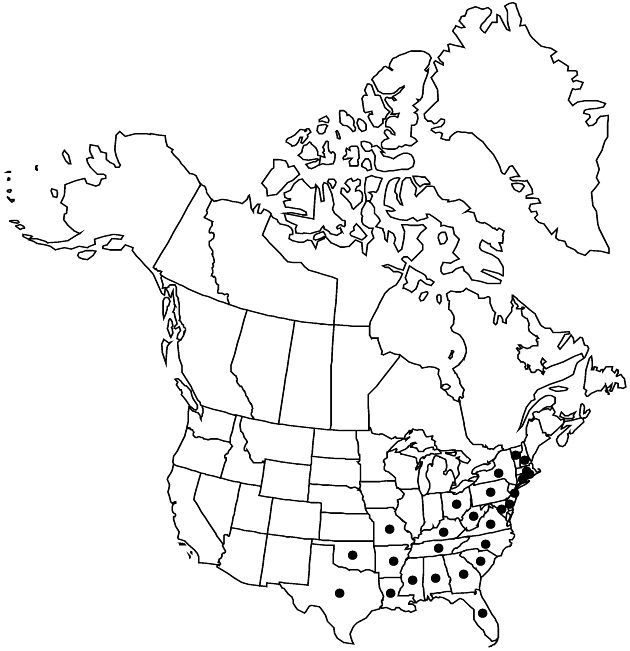familyAsteraceae
genusSolidago
sectionSolidago sect. Solidago
subsectionSolidago subsect. Venosae
speciesSolidago odora
subspeciesSolidago odora subsp. odora
Solidago odora subsp. odora
Stems puberulent in lines or strips decurrent from distal leaf-bases (at least). Mid cauline leaves mostly 40–110 × 5–15 (–20) mm (4–15 times as long as wide). 2n = 18.
Phenology: Flowering Jul–Oct.
Habitat: Sandy and clay soils, dry open woods, pine barrens, damp peaty pine woods, sand hills, edges of oak and pine woods, disturbed areas, roadside embankments
Elevation: 0–700 m
Distribution

Ala., Ark., Conn., Del., Fla., Ga., Ky., La., Md., Mass., Miss., Mo., N.H., N.J., N.Y., N.C., Ohio, Okla., Pa., R.I., S.C., Tenn., Tex., Vt., Va., W.Va., Mexico (Tamaulipas), Mexico (Veracruz)
Discussion
Subspecies odora is replaced by subsp. chapmanii in central and southern Florida.
Selected References
None.
Lower Taxa
None.
"thin" is not a number.
... more about "Solidago odora subsp. odora"
introrse +
connate +
distinct +
herbaceous +
acute +
scarious +
hirsute +
papillate +
paniculiform +
cone--shaped +
continuous +
not 3-nerved +
withering +
not persisting +
rounded +
winged +
entire +
flowering +
lanceolate;linear-lanceolate or narrowly ovate +
reduced +
ribbed +
linear-lanceolate +
secund +
recurved;ascending;spreading +
proximalmost +
elongate +
stigmatic +
barbellate +
longer +
persistent +
25;45 +
absent +
woody +
absent +
ampliate +
monomorphic +
dimorphic +
1.4mm;2.3mm +
staminate +
straight +
3-nerved +
resinous +
translucent gland-dotted +
mid +
distal +
distinct +
proximal +
1;5 +
bisexual +
dispersed +
Sandy and clay soils, dry open woods, pine barrens, damp peaty pine woods, sand hills, edges of oak and pine woods, disturbed areas, roadside embankments +
secund +
discoid +
singly +
indeterminate +
75;350 +
pyramidal +
clavate +
surrounding +
campanulate +
1.4mm;2.5mm +
0.4mm;0.9mm +
pronounced +
3-nerved +
alternate +
basal +
distal +
proximal +
erect;spreading +
? (?) +
winged +
flowering +
scarious +
attenuate +
translucent +
scabroso-strigillose +
prominent +
setiform +
2-carpellate +
inferior +
attached +
anatropous +
persistent +
tough +
thick +
absent +
connate +
winged +
not persisting +
proximal +
short-strigillose +
eglandular +
resinous +
yellowish +
not striate +
persistent +
distinct +
falling +
glabrous +
acute +
unequal +
3-nerved +
ovate-oblanceolate +
arching +
flowering +
largest +
flowering +
Hort. Kew. +
1789 +
pistillate +
absent +
fertile +
epaleate +
pitted +
convex +
woody +
fibrous +
exalbuminous +
modifed +
3;4 +
alternate +
branched +
puberulent +
proximal +
glabrous +
decurrent +
triangular +
2-branched +
glabrous +
Solidago odora subsp. odora +
Solidago odora +
subspecies +
shorter +
not persisting +
sessile +
perennial +
cauline +